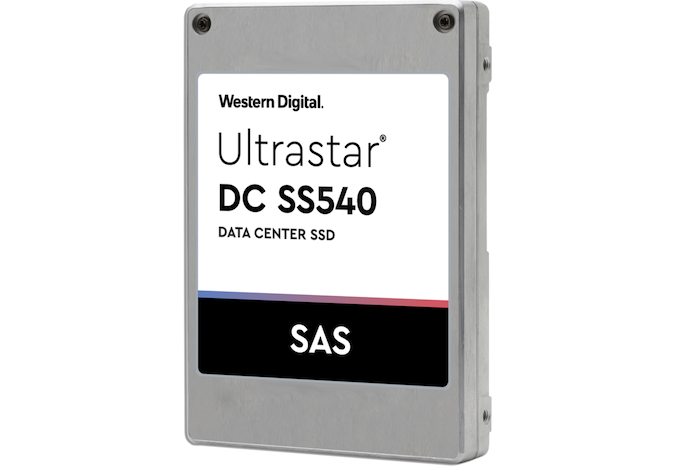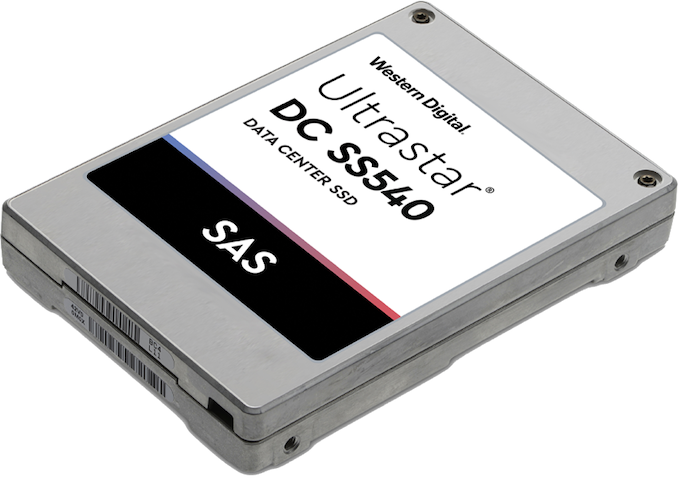Western Digital Ultrastar DC SS540 SAS SSDs: Up to 15.36 TB, Up to 3 DWPD
by Anton Shilov on November 6, 2019 3:00 PM EST
Western Digital has introduced its new series of SSDs designed for mission critical applications, including OLTP, OLAP, hyper converged infrastructure (HCI), as well as software-defined storage (SDS) workloads. The Ultrastar DC SS540 drives are aimed at mixed and write intensive workloads and can be configured accordingly. Since the SSDs use an SAS 12 Gbps interface, they are drop in compatible with existing machines.
The Western Digital Ultrastar DC SS540 is based on the company's sixth-generation dual-port SAS 12 Gbps platform co-developed with Intel as well as 96-layer 3D TLC NAND memory (presumably, also from Intel) and comes in a 2.5-inch/15 mm form-factor. The new SSDs are drop-in compatible with existing servers that support 9, 11, and 14 W per drive power options (SKUs with higher power consumption offer higher random read/write speeds).
As is traditional for SAS SSDs from Western Digital and Intel, the Ultrastar DC SS540 supports extended error correction code (ECC with a 1x10^-17 bit error rate) to ensure high performance and data integrity, exclusive-OR (XOR) parity in case a whole NAND die fails, and parity-checked internal data paths. In addition, the Ultrastar SS540 complies with the T10 Data Integrity Field (DIF) standard, which requires all interconnect buses to have parity protection (on the system level), as well as a special power loss data management feature that does not use supercapacitors. As usual, Western Digital's Ultrastar SS540 will be available in different SKUs with capabilities like instant secure erase and/or TCG+FIPS encryption to conform with various security requirements.
The manufacturer plans to offer the Ultrastar DC SS540 rated for 1 or 3 drive writes per day (DWPD) to target different workloads. The former will offer capacities between 960 GB and 15.36 TB, whereas the latter will feature capacities from 800 GB to 6.4 TB. The new lineup does not include drives rated for 10 DWPD and less than 1 DWPD, so those who need higher or lower endurance (as they run extremely read intensive or extremely write intensive workloads) will have to use previous-generation offerings from Western Digital. When it comes to warranty and MTBF, the drives are rated for a 0.35% annual failure rate (AFR), 2.5 million hours MTBF and are covered with a five-year limited warranty (or the max PB written, whichever occurs first).
As far as sustained performance is concerned, the Ultrastar DC SS540 is rated for up to 2130 MB/s sequential read/write speed, up to 470K IOPS random write IOPS, and up to 240K random write IOPS, depending on exact model, which is generally in line with performance of the Ultrastar DC SS530 SSDs launched last year. Traditionally, higher capacity SSDs are slightly slower when it comes to writes and mixed workloads, but those who need maximum performance can always use more drives to hit desired speeds.
Western Digital’s Ultrastar DC SS540 SSDs are currently sampling and qualified by select clients of the company. The manufacturer plans to start commercial shipments of the drives in the Q1 2020.
| HGST Ultrastar SS540 Series Specifications | |||
| 3 DWPD | 1 DWPD | ||
| Capacities | 6.4 TB 3.2 GB 1.6 TB 800 GB |
15.36 TB 7.68 TB 3.84 TB 1.92 TB 960 GB |
|
| Form Factor | 2.5"/15mm | ||
| Interface | SAS 6/12 Gb/s, dual port for 12 Gb/s | ||
| Controller | Proprietary | ||
| NAND | 96-layer 3D TLC NAND |
||
| Sequential Read | 2116 ~ 2130 MB/s | 1985 ~ 2130 MB/s | |
| Sequential Write | 1008 MB/s ~ 2109 MB/s | 1985 MB/s ~ 2130 MB/s | |
| Random Read (4 KB) IOPS | 237K ~ 470K IOPS | 237K ~ 470K IOPS | |
| Random Write (4 KB) IOPS | 128K ~ 240K IOPS | 79K ~ 110K | |
| Mixed Random R/W (70:30 R:W, 4KB) Max IOPS |
182K ~ 300K IOPS | 143K ~ 200K IOPS | |
| Read/Write Latency (average) | 140/60 μs ~ 150/80 μs | 140/90 μs ~ 150/300 μs | |
| Power | Idle | 3.7 W (<15 TB) - 4.7 W (>15 TB) | |
| Operating | 9 W, 11 W, 14 W (configurable) | ||
| Endurance | DWPD | 3 | 1 |
| Max. PB | 6.4 TB: 36,150 TB 3.2 TB: 17,150 TB 1.6 TB: 9,410 TB 800 GB: 4.700 TB |
15.36 TB: 30,110 TB 7.68 TB: 15,050 TB 3.84 TB: 7,000 TB 1.92 TB: 3,760 TB 960 GB: 1,880 TB |
|
| Encryption | AES-256 (?) TCG + FIPS |
||
| Power Loss Protection | Yes | ||
| MTBF | 2.5 million hours | ||
| Warranty | Five years or max PB written (whichever occurs first) | ||
| Models | WUSTR6464ABSS20x WUSTR6432BSS20x WUSTR6416BSS20x WUSTR6480BSS20x |
WUSTVA1A1BSS20x |
|
| Legend for Model Numbers | Example: WUSTR6464ASS201=6.4TB, SAS 12Gb/s, TCG W = Western Digital U = Ultrastar S = Standard TR = NAND type/endurance (TM=TLC/mainstream endurance, TR=TLC/read-intensive) 64 = Full capacity (6.4TB) 64 = Capacity of this model 15 = 15.2TB 76 = 7.6TB 38 = 3.84TB 32 = 3.2TB 19 = 1.92TB 16 = 1.6TB 96 = 960GB 80 = 800GB 48 = 480GB 40 = 400GB A = Generation code S = Small form factor (2.5” SFF) S2 = Interface, SAS 12Gb/s 1 = Encryption setting 0 = Instant Secure Erase 1 = TCG Enterprise encryption 4 = No encryption/Secure Erase 5 = TCG+FIPS |
||
Related Reading:
- HGST Launches Ultrastar DC SS530 SSDs: 3D TLC NAND, 15.36 TB, SAS 12 Gbps
- Western Digital Reveals Ultrastar DC SN340 SSDs for Read Intensive Workloads
- Western Digital Launches HGST Ultrastar SS300 SSDs: 3D NAND for Data Centers
- HGST Ultrastar SS200 SSD: Up to 7.68 TB, 1.8 GB/s, Dual-Port SAS 12 Gbps
- HGST Ultrastar SN200 Accelerator: 7.68 TB Capacity, 6.1 GB/s Read Speed, 1.2M IOPS
Source: Western Digital











20 Comments
View All Comments
eek2121 - Wednesday, November 6, 2019 - link
awe no pricing? ;)TennesseeTony - Wednesday, November 6, 2019 - link
Somewhere between a SpaceX LEO launch and a NASA SLS launch to the moon.... :Dshabby - Wednesday, November 6, 2019 - link
I'm in for two!eek2121 - Wednesday, November 6, 2019 - link
Some would pay a considerable amount of money for a 15 TB SAS SSD.mrvco - Wednesday, November 6, 2019 - link
I'll dream about 4x 18TB SSDs sliding into my Synology NAS tonight.ballsystemlord - Wednesday, November 6, 2019 - link
I'm a similar dream.I wonder what the pricing is like....
close - Thursday, November 7, 2019 - link
You know how the saying goes, if you have to ask...kingpotnoodle - Thursday, November 7, 2019 - link
Yeah we do, and the performance numbers compare favourably to Samsung PM1643. It's the density and power saving that wins it, sometimes need to get a lot of fast storage in 1U rather than 2U servers, less racks, less power, fewer drives to maintain.JohnLook - Wednesday, November 6, 2019 - link
@Anton Shilovare the ms units correct? It seems like a huge latency for an ssd ...
eek2121 - Wednesday, November 6, 2019 - link
given all the hardware features included, it wouldn't surprise me.